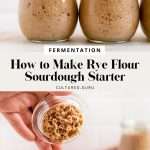- Organic Sprouted Rye Flour
- Water
- The feeding ratio is adjustable in these instructions. I suggest following the 1:2 ratio for the first 7 days; then you can adjust to a thicker starter that holds a “photo-worthy” rise longer. Please read the blog post above this recipe for more on this.
- Step One (Day 1) In a bowl combine 50 grams of organic sprouted rye flour and 100 grams of water.
- Use a spatula to combine the flour and water. Stir until there are no clumps and the mixture is smooth.
- Scoop the mixture into a clean glass jar.
- Loosely set a lid on the top or secure a breathable covering to the jar (i.e. cheesecloth) and leave the mixture on the counter for 24 hours.
- Step Two (Day 2) Stir sourdough starter mixture.
- Add 50 grams of organic sprouted rye flour and 100 grams of water to the starter mixture in the jar. Mix and scrape down the sides.
- Replace a breathable lid. Leave the mixture on the counter for 24 hours.
- Step Three (Days 3-7, Feeding and Discarding) to a clean bowl add 50 grams sourdough starter mixture from the previous day, 50 grams of organic sprouted rye flour and 100 grams of water
- Stir until evenly combined, and scoop into a clean jar.
- Replace the breathable lid and allow it to ferment for 24 hours.
- Discard any remaining original starter mixture. Or you can find fun ways to use sourdough starter discard here.
- Repeat steps 9 through 12 every 24 hours until you reach 7 days. At this point, it should be bubbly.
- (The Night Before Baking) Feed your starter 8 hours before you plan to make bread dough.
- To keep your starter active and to make starter suitable for baking, use the following ratios for feeding: 10% starter, 50% flour, 40% water. (example: you need 200 grams of starter for a recipe, so you want to make 250 grams of starter, so you have some left to feed. You will mix 25 grams of starter, 125 grams of flour, and 100 grams water); These amounts work for most flour, but add a little more water if it’s too dry. Starters are forgiving.
- (Baking Day) Perform a float test by dropping a teaspoon of starter into a cup of room-temperature water. If it floats, it’s ready for use. If your starter does not float, continue to feed and discard until it passes the float test.
- If your starter passed the float test, put some starter aside to continue feeding. Use the rest of the starter for your baking recipe.
- Again, to keep your starter active and to make starter suitable for baking, use the following ratios for feeding: 10% starter, 50% flour, 40% water. These amounts work for most flour, but add a little more water if it’s too dry. Starters are forgiving.

